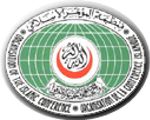|
[Summit
History]
[3rd
Extraordinary Summit SecGen's Report]
[3rd
Extraordinary Summit King Abdullah Speech]
[3rd
Extraordinary Summit Communiqu�]
[Mecca
Declaration]
 The
Organization of the Islamic Conference (OIC) is an
inter-governmental organization grouping fifty-six States. These States
decided to pool their resources together, combine their efforts and
speak with one voice to safeguard the interest and ensure the progress
and well-being of their peoples and those of other Muslims in the world
over. The
Organization of the Islamic Conference (OIC) is an
inter-governmental organization grouping fifty-six States. These States
decided to pool their resources together, combine their efforts and
speak with one voice to safeguard the interest and ensure the progress
and well-being of their peoples and those of other Muslims in the world
over.
The Organization was established in Rabat, Kingdom of
Morocco, on 12 Rajab 1389H (25 September 1969) when the First meeting of
the leaders of the Islamic world was held in this city in the wake of
the criminal arson perpetrated on 21 August 1969 by Zionist elements
against Al-Aqsa Mosque, in occupied Jerusalem. It was indeed in order to
defend the honour, dignity and faith of the Muslims, to face this bitter
challenge launched in the holy city of Al-Quds so dear to them and
against the Mosque of Al-Aqsa, the first Qibla and third holiest Shrine
of Islam, that the leaders of the Muslim world, at their Summit in
Rabat, seized that event - which brought about unanimous worldwide
condemnation and reprobation - to think together of their common cause
and muster the force required to overcome their differences, unite and
lay the foundations of this large grouping of States, that is, the
Organization of the Islamic Conference which they entrusted, in absolute
priority, with liberating Jerusalem and Al-Aqsa from Zionist occupation.
Six months after that historical meeting, i.e. in
Muharram 1390H (March 1970), the First Islamic Conference of Ministers
of Foreign Affairs held in Jeddah set up a permanent General
Secretariat, to ensure a liaison among Member States and charged it to
coordinate their action. The Conference appointed its Secretary General
and chose Jeddah as the Headquarters of the Organization, pending the
liberation of Jerusalem, which would be the permanent Headquarters.
Two and a half years after Rabat, in Muharram 1392H
(February 1972), the Islamic Conference of Foreign Ministers, meeting in
its Third Session, adopted the Charter of the Organization, whose
purpose is to strengthen solidarity and cooperation among Islamic States
in the political, economic, cultural, scientific and social fields.
Under the Charter, the Organization aims to:
1. Strengthen:
-
Islamic solidarity among Member States;
-
Cooperation in the political, economic, social,
cultural and scientific fields:
-
The struggle of all Muslim people to safeguard
their dignity, independence and national rights.
2. Coordinate action to:
3. Work to:
The Charter also enumerates principles which OIC
Member States undertake to inspire themselves from, in order to achieve
the objectives of the Organization.
The Charter also enumerates the principles governing
OIC activities, namely:
-
A
pledge to refrain, in relations among Member States, from resorting
to force or threatening to resort to the use of force against the
unity and territorial integrity or the political independence of any
one of them
In
order to achieve its objectives, the Organization has main bodies,
secondary organs, institutions and specialized committees.
The
Islamic Conference is composed of the following main bodies:
In
order to coordinate and boost its action, align its view points and
stands, and be credited with concrete results in the various fields of
cooperation: political, economic, cultural, social, spiritual and
scientific, among Member States, the Organization has created different
committees, nearly all, at ministerial level, a number of which are
chaired by Heads of State. The Al-Quds Committee, the Standing Committee
for Information and Cultural Affairs (COMIAC), the Standing Committee
for Economic and Trade Cooperation (COMCEC), the Standing Committee for
Scientific and Technical Cooperation (COMSTECH) and the Islamic Peace
Committee are the ones Chaired by Heads of State. Fourteen Committees
which have been thus established, deal with other important issues such
as Palestine, the Sahel, Afghanistan, Kashmir etc.
The
number and types of secondary organs and institutions, working toward
the achievement of the OIC objectives, have been steadily increasing,
and cover various areas of cultural, scientific, economic, legal,
financial, sports, technological, educational, media, as well as
vocational, social and humanitarian. Depending on their degree of
autonomy vis-a-vis the parent organization, they are classified as
subsidiary and specialized organs, or affiliated institutions.
Last
but not least, it is worth mentioning that by the 3rd year of the World
Decade for Cultural Development launched by the United Nations in 1988
under the auspices of UNESCO - the Organization of the Islamic
Conference had built Islamic Colleges, and Cultural Institutes and
Centres to spread Islamic culture and dispense the Teaching of Arabic,
the language of the Holy Qur'an, as well as other languages.
Source:
OIC
|


